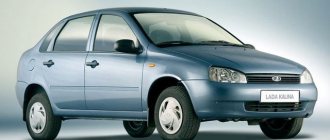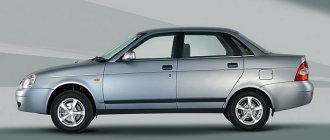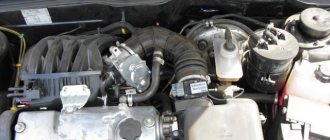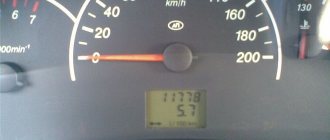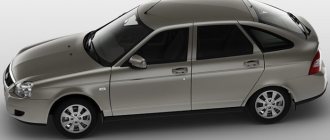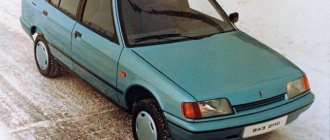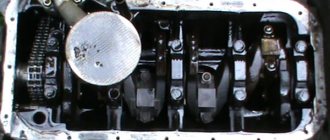Engine VAZ 21128-100026080. Characteristics of the VAZ 21128 engine.
The engine is four-stroke, with distributed fuel injection, in-line, with an overhead camshaft. The engine cooling system is liquid, closed type, with forced circulation of liquid. The engine has a combined lubrication system: pressure and splash.
| Number of cylinders: | 4 |
| Cylinder displacement, l: | 1,796 |
| Compression ratio: | 11,5 |
| Rated power at a crankshaft speed of 5000 rpm: | 75 kW.-(105 hp) |
| Cylinder diameter, mm: | 82,5 |
| Piston stroke, mm: | 84 |
| Number of valves: | 16 |
| Minimum crankshaft speed, rpm: | 800-850 |
| Maximum torque at 3000-3200 rpm, N*m: | 160 |
| Cylinder operating order: | 1-3-4-2 |
| Octane number of gasoline: | 95 (unleaded) |
| Fuel supply system: | Electronically controlled distributed injection |
| Spark plug: | AU17DVRM, BCPR6ES(NGK) |
| Weight, kg: | 117 |
Engine Features.
The VAZ 21128 engine can be used for installation on VAZ 2110, VAZ 2111, VAZ 2112 cars and their modifications.
Characteristics of engine 21128
What cars have a 4×100 bolt pattern?
list with comments The priority task of the Super-Auto manufacturer was to increase the power of the 21124 internal combustion engine, which did not bend valves, which was taken as a basis, so changes took place in the engine:
- the engine diagram remains the same - DONS timing diagram with 2 overhead camshafts;
- a volume of up to 1.8 liters was added - the combustion chambers were enlarged, the cylinders had a size of 82.5 mm, the piston stroke was added to 84 mm;
- the safety of the valves is ensured - deep holes protect them from bending when they meet the pistons at the moment the timing belt drive breaks;
- compression ratio 10.5 units;
- Controller firmware January 5.1, throttle pipe cross-section 51 mm.
Forced motor 21128
As a result, the manual contained a description of the engine parameters - power in the region of 95 - 105 hp. With. and torque at 3200 rpm is about 160 - 162 Nm. The pistons were designed jointly by engineers from AVITI and Super-Auto, since a similar size did not exist in the AvtoVAZ line in principle. The connecting rods are also created for this internal combustion engine, length 129 mm, fastening with a 19 mm pin, fit on a non-standard crankpin 41.5 mm.
With a declared service life of 150,000 km, the manufacturer’s engine could not withstand 100,000 km and consumed a lot of oil - up to 1 liter per 1000 km. The environmental standard has dropped to Euro 2. A “long” piston stroke leads to increased loads on the side surfaces of the cylinders and intense wear of the rings/pistons. This results in high engine oil consumption and the system overheats.
https://youtube.com/watch?v=MkhhtUVGEBQ
https://youtube.com/watch?v=MkhhtUVGEBQ
A year later, Super-Auto management removed the ICE marking 21128-26 from production, replacing it with the following version designated 21128-27:
- the engine does not bend the valve, so a conventional timing belt with a service life of 50 - 90 thousand km is installed;
- cylinders returned to 82 mm size, lightweight pistons from Federal Mogul;
- Mecaprom connecting rods were used;
- a new version of controller firmware has been created;
- valve lift increased to 8.3 mm (0.7 mm more than the original);
- The eco standard has increased to Euro-4.
Modified version of the motor
Since two versions of the 21128 motor were developed, the technical characteristics have changed over time:
| Manufacturer | JSC Super-Auto |
| Engine brand | 21128 |
| Years of production | 2013 (2014) – … |
| Volume | 1597 cm3 (1.6 l) |
| Power | 78 kW (106 hp)/90.5 kW (123 hp) |
| Torque | 148 Nm (at 5800 rpm)/165 Nm (at 4000 rpm) |
| Weight | 116 kg |
| Compression ratio | 10,5 |
| Nutrition | injector |
| Motor type | in-line |
| Injection | distributed electronically controlled |
| Ignition | coil for each spark plug |
| Number of cylinders | 4 |
| Location of the first cylinder | TVE |
| Number of valves on each cylinder | 4 |
| Cylinder head material | aluminum alloy |
| Intake manifold | combined with receiver, polymer |
| An exhaust manifold | catalyst |
| Camshaft | 2 pcs., DONS circuit |
| Cylinder block material | cast iron |
| Cylinder diameter | 82.5 mm, then 82 mm |
| Pistons | lightweight, manufacturer Federal Mogul |
| Crankshaft | original |
| Piston stroke | 84 mm |
| Fuel | AI-95 |
| Environmental standards | Euro-2/4 |
| Fuel consumption | highway – 5.9 l/100 km combined cycle 7.5 l/100 km city – 9.8 l/100 km |
| Oil consumption | 0.7 – 1 l/1000 km, then 0.3 l/1000 km |
| What kind of oil to pour into the engine by viscosity | 5W-30 and 10W-40 |
| Which engine oil is best by manufacturer | Liqui Moly, LukOil, Mannol, Mobil |
| Oil for 21128 according to composition | synthetics, semi-synthetics |
| Engine oil volume | 3.5 l |
| Operating temperature | 95° |
| Motor life | declared 150,000 km actual 100,000 km |
| Adjustment of valves | hydraulic compensators |
| Cooling system | forced, antifreeze |
| Coolant quantity | 7.8 l |
| water pump | with metal impeller |
| Candles for 21128 | BCPR6ES from NGK or domestic AU17DVRM |
| Gap between spark plug electrodes | 1.1 mm |
| Timing belt | Gates, width 22 mm, service life 200,000 km |
| Cylinder operating order | 1-3-4-2 |
| Air filter | Nitto, Knecht, Fram, WIX, Hengst |
| Oil filter | catalog number 90915-10001 replacement 90915-10003, with check valve |
| Flywheel | increased damper size |
| Flywheel mounting bolts | M10x1.25 mm, length 26 mm, groove 11 mm |
| Valve stem seals | code 90913-02090 inlet light code 90913-02088 exhaust dark |
| Compression | from 14 bar, difference in adjacent cylinders maximum 1 bar |
| XX speed | 800 – 850 min-1 |
| Tightening force of threaded connections | spark plug – 31 – 39 Nm flywheel – 62 – 87 Nm clutch bolt – 19 – 30 Nm bearing cap – 68 – 84 Nm (main) and 43 – 53 (rod) cylinder head – three stages 20 Nm, 69 – 85 Nm + 90° + 90° |
Even after modification of the power drive, major repairs are possible after 150,000 km. This is due to the remaining “long” piston stroke, increased loads on the cylinder walls, and intensive production of ShPG parts.
Domestic 16-valve engines
Observing heated debates in the comments, I often notice that people simply do not know how the 124 engine differs from the 126. Let's look at the line of sixteen-valve engines from VAZ.
A little preface. When faced with 16-valve VAZs at the household level, remember that such cars are always equipped with 14-inch wheels, since there are enlarged ventilated brake discs at the front.
So, the “gear” came from an 8-valve engine. In the articles you can find mentions that VAZ wanted to create a powerful and economical engine, and so, the “gear” will never be more economical than an eight-valve engine. Consumption 16 cl. engine 7.5 - 10 liters, depending on the dynamics.
The first engine from the line was 21120 (hereinafter referred to as the 120th
). The volume is one and a half liters, equipped with an ignition module, the valves bend. Visually different is the cast intake manifold. It was developed for cars 2110-2112, installed in various modifications such as “Premier” and 2112 in a two-door hatchback body. It went into production in 1996 and was installed on cars until 2004. If today you buy a car with such an engine, then most likely it has already undergone repairs and a “plug-in” piston is installed on it.
In 2004, the 120th engine was replaced by a new one with the index 21124 (hereinafter referred to as the 124th
). In addition to cars of the tenth family, it was installed on the VAZ 2113 and VAZ 2114.
This engine does not bend the valves, thanks to grooves on the pistons, this is its main difference from its predecessor. It is easy to distinguish by its plastic intake manifold. In addition, the ignition module has been replaced with individual coils for each cylinder. Engine capacity increased to 1.6 liters.
Many people call this engine the most balanced in the VAZ line, and I think this is true. Its service life is at least 200 thousand, if you drive “without fanaticism”.
Technical characteristics of super car 2114
Powertrain super car
For 10 years, the VAZ 2114 super car has been equipped with several internal combustion engine options. From the very beginning it is worth mentioning the 1.5 liter and 8 valve engine, it produced 78 hp. Fuel consumption of the internal combustion engine of the super car VAZ 2114 was 7.3 liters of fuel for every 100 km with mixed driving. After car factories began installing injection engines on the VAZ 2114, its power increased. But if you look at it from the other side, his gasoline consumption has decreased.
But already starting in 2004, an internal combustion engine with a displacement of 1.6 was produced; 81 hp Such an engine with mixed driving for 100 km. consumes 7.6 liters of fuel. In the same year, a new 1.6 liter engine with a 16 valve system was released, which gives the car 89 hp. The passport states that such an internal combustion engine already consumes 7.5 liters of fuel per 100 km in mixed driving. But already in 2007, this internal combustion engine was subjected to serious modifications, while the previous level of 1.6 was left in it, and the power was increased to 98 hp.
Transmission
On a super car, all power plants begin to work together with a 5-speed manual transmission; it has undergone repeated improvements. The gearbox and full suspension were specially developed by Russian mechanical engineering engineers.
Chassis
This vehicle was developed on the platform of previous models. Special McPherson struts were installed on the front wheels of the super car, and struts with trailing arms or coil springs were installed on the rear 2 wheels. Driving a car for a long time quickly gets your hands tired, since it was not equipped with power steering on the steering wheel. The steering wheel of our hatchback itself is made in the form of a gear - a nut. The front wheels are equipped with disc brakes, and the rear wheels are equipped with a drum mechanism. And if we take, for example, an average speed limit of 80 km/h, and there are passengers inside the vehicle, the resulting braking distance during sudden braking will be 40 meters.
Safety
The safety level on the VAZ 2114 super car is very low. Car developers did not provide for the installation of front airbags. The body is made of thin metal, which in the event of an accident is not able to provide the people in the car with proper safety. Even during minor accidents, the body is severely deformed.
Engine VAZ 21128 characteristics
Years of manufacture - (2003 - present day) Cylinder block material - cast iron Power system - injector Type - in-line Number of cylinders - 4 Valves per cylinder - 4 Piston stroke - 84 mm Cylinder diameter - 82.5 mm (82 mm since 2014) Grade compression - 10.5 Engine capacity 128 - 1796 cm3 (1774 cm3 since 2014) Engine power 21128 - 98 hp /5200 rpm (123 hp / 5500 rpm) Torque - 162 Nm / 3200 rpm (165 Nm / 4000 rpm) Fuel - AI95 Fuel consumption - city 9.8 l. | track 5.4 l. | mixed 7.5 l/100 km Oil consumption in the 21128 engine - about 300 g/1000 km Weight of the VAZ 21128 engine - 117 kg Geometric dimensions of the engine (LxWxH), mm - Oil in the VAZ 21128 engine: 5W-30 5W-40 10W-40 15W40 How much oil is in engine 21128: 3.5 l. When replacing, fill in about 3.2 liters.
Engine life 21128: 1. According to the plant – 200 thousand km 2. In practice – low
TUNING Potential – 400+ hp. Without loss of resource - up to 120 hp.
Design features of the VAZ-21128 power unit
The new 28th engine has a displacement of 1.8 liters, is built on the basis of the 16-valve engine 21126 and is produced in small batches. A larger volume than is typical for the basic design was obtained only through the use of a ShPG with an increased stroke length. The pistons for this ShPG are manufactured by the Federal-Mogul concern, and sets of crankshafts and connecting rods are purchased in Italy. Let's move on to consider the dynamic characteristics.
Unfortunately, we cannot provide a graph of torque and power. But information related to the VAZ-21128 engine is freely available:
- Maximum power value – 123 hp. (for motor 21126 the parameter is 98 hp);
- The highest torque is 165 N*m (for the “regular Priora” it is 145 N*m);
- A torque of 145 N*m is achieved at low speeds not exceeding 2500 rpm;
- The range of 3500-4000 rpm is characterized by a torque value close to the maximum (165-166 N*m);
- The warranty period is 3 years or 100,000 km.
This is the engine that AvtoVAZ, or more precisely, its subsidiary Super-Avto, prepared for us. Note that the VAZ-21128 power unit complies with Euro-4 standards (the car plant did not present any surprises here). It is recommended to refuel cars equipped with modern 2112X engines only with AI-95 gasoline. However, owners often compromise, using 92nd gasoline for very specific reasons. We discussed earlier what this could lead to.
Malfunctions and repairs of the Super Auto 21128 engine
The first version of the 128 engine was created on the basis of the VAZ 21124 ten-seater engine, but with cylinders bored out by 0.5 mm, a crankshaft with a stroke of 84 mm, a connecting rod of 129 mm, with lightweight pistons of our own design, which are close in weight to those of Priora, the pistons have counterbores , therefore, if the timing belt breaks, the VAZ 21128 engine does not bend the valve. The cylinder head remained from the 124 engine, with slightly modified combustion chambers. Engine VAZ 21128 1.8 l. injection in-line 4-cylinder with overhead camshafts, timing belt driven. It was not possible to find official data on the service life of motor 21128, but in practice it is not extremely high, this can be explained simply: the height of the block remained the same and in order to increase the piston stroke with a long-stroke crankshaft, it was necessary to use short connecting rods, due to this serious stresses appeared in the piston due to the increased angle of inclination of the connecting rod during rotation and the piston now presses with great force on the side walls of the cylinders, as a result of which there is a high load on the connecting rod itself, on the walls, on the piston and rings. What we have: more wear and the problem of oil burning, very strong burning... from 0.7-1 liters. and up to 3+ l. per 1000 km. Major repairs often occur before reaching 100 thousand km; reviews of the 21128 engine are among the most negative. To all these shortcomings we should add the classic shortcomings inherent in all 124 and 126 engines (written about HERE and HERE) and the result will be a Super Auto 1.8 engine, do you need this? Decide for yourself.
Typical faults
In principle, the 21124 motor is considered “not capricious”, however, there are breakdowns unique to this version:
| Antifreeze leaks between the block and the cylinder head | asbestos gasket has a low resource | replacing the cylinder head gasket |
| Starter grinding noise | flywheel ring wear | replacement of the entire ring or flywheel, installation of a dual-mass modification is possible |
| The engine stalls after starting | 1) failure of the control system 2) the fuel inlet pipe is depressurized 3) the pressure inside the power system has dropped 4)damaged connection of ignition coils or loose fasteners | 1) flashing or repair 2) replacing gaskets, tightening connections 3) repair of the ramp or replacement of the unit 4) tightening the fastening, replacing coils |
| A warm engine will not start | clogging of the power system or air filter | cleaning fuel lines, replacing air filter |
The tightening force of all fasteners must be maintained in accordance with the manufacturer's manual. For example, oil stains under the engine can be caused not only by wear of the oil pan gasket, but also by insufficient tightening torque, including the cylinder head. Less often, the gasket of the emergency pressure sensor of the lubrication system fails.
Engine tuning VAZ 21128 1.8
Engine tuning 128 for the city
For the city, it would be correct to install a receiver, a 54 mm damper, a zero filter, a 4-2-1 spider on such an engine and get the legal +\- 120 hp. You should forget about the top shafts, the motor has a low torque and doesn’t like revs, so you won’t be able to spin it up, and at the same time you won’t be able to inflate it with a compressor, the crankshaft is too weak. Therefore, in order to tune the Priora 1.8 engine, you need to change the bottom, remove the 84 elbow and install 80 mm. You can bore the cylinders up to 84 mm, this configuration will spin better. One way or another, we will come to the usual tuning of the VAZ 21126 engine, and you can read about it HERE.
Source
Description of the design of the Lada 21128 16 valve engine
For the first time, the Super Auto company took the 21124 engine as the basis for creating a 1.8-liter internal combustion engine. To increase the working volume of their power unit, they bored out the cylinders by 0.5 mm, and also installed a different crankshaft with a piston stroke of 84 mm. They also used a lightweight connecting rod and piston group of their own design. As a result, the engine power increased by 17 hp.
In 2014, the company used a more modern VAZ 21126 engine for modification. This time the cylinders were not bored, they simply replaced the crankshaft and ShPG with parts from Mecaprom. The lift of the intake and exhaust valves was increased from 7.6 mm to 8.3 mm. All this added 25 hp.
Blogger Vlas Prudov talks about all the pros and cons of Super Auto products.
The Kolesa website spoke in detail about the second generation of such power units
Source
Engine tuning
Since the 21128 engine is already a boosted version of the 21126, the possibilities for increasing power are limited:
- The piston stroke is already “long”, if you additionally bore the cylinders, it will take a long time to select a suitable ShPG and crankshaft;
- a new design receiver is already installed on the intake tract, but it is possible to install a “zero” air filter and a damper with a cross-section of 54 mm, a “spider” on the exhaust manifold instead of the standard one, this will bring the power closer to 130 hp. With.;
- tuning is possible by turbocharging the internal combustion engine - PK-23-1, cylinder head gasket from the 2112 engine, Nuzhdin 8.8 camshafts, channel cutting, Bosch 107 injectors and 51 mm exhaust pipe.
The main problem remains the long-stroke crankshaft, so upgrading this engine either does not bring a noticeable effect or turns out to be very expensive. We have to change the design laid down by the manufacturer, which is initially too aggressive.
Thus, before buying a car from Super-Auto with a 21128 engine, you should seriously think about whether it is worth choosing such power, overpaying for road tax and insurance, being content with a resource of just over 100,000 km. In addition, the pistons are not protected from “meeting” the valves, despite the Gates belt with a service life of 200,000 km.
Source
Advantages and disadvantages
An important feature of the first version of the motor was the safety of the valves. In the second option this is not the case; the pistons bend the valves when they meet.
In modification 26, the cylinder head has bored combustion chambers, and the block itself has an increased cylinder size. After modification, motor 27 became safer for the environment.
Due to the increased power, it is recommended to operate internal combustion engines only with manual transmissions.
Engine
Lada Priora has undergone changes several times, both externally and technically. The appearance, power plant and transmission changed.
Below is an example of engines that were installed on the VAZ 2170-72.
Engine 21116 (8 valves)
This engine was installed on the VAZ 2114 and Lada Kalina, and was later inherited by the Priora. The power of this internal combustion engine is 80 hp. with a volume of 1.6 liters, which is very small. Such an engine does not have good dynamics, and it is difficult for it to “drag” the body of the Priora.
Pros:
- Does not bend valves;
- Cheaper spare parts;
Easy to maintain;
Minuses:
The installation of such an engine continued until 2021.
Engine 21126 (16 valves)
16 valve engine with more power and torque compared to 116. It is a modified model of the 124 engine. Its power is 98 hp. with a volume of 1.6 liters.
Pros:
- Great power;
- No noisy operation;
Minuses:
- Bend valves when the belt breaks;
- Expensive spare parts;
Engine 21127 (16 valves)
The modified 126 engine received the index 21127; the intake in this engine was changed, thereby increasing the power to 106 hp. with the same volume of 1.6 liters. They began to install a new cable gearbox for this engine.
Pros:
- High power;
- No noisy operation;
Minuses:
- Bend valves;
- Expensive spare parts;
Engine 21128 (16 valves)
This engine was specially designed for more powerful Lada cars with the “Super Auto” nameplate. The power of this engine has increased, as has its volume. The number of horsepower in the super car engine increased to 123, and the volume to 1.8 liters, which radically affected the dynamics of the car.



